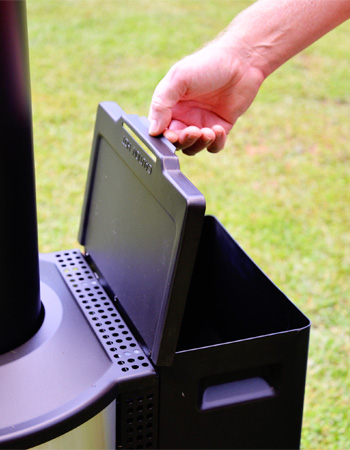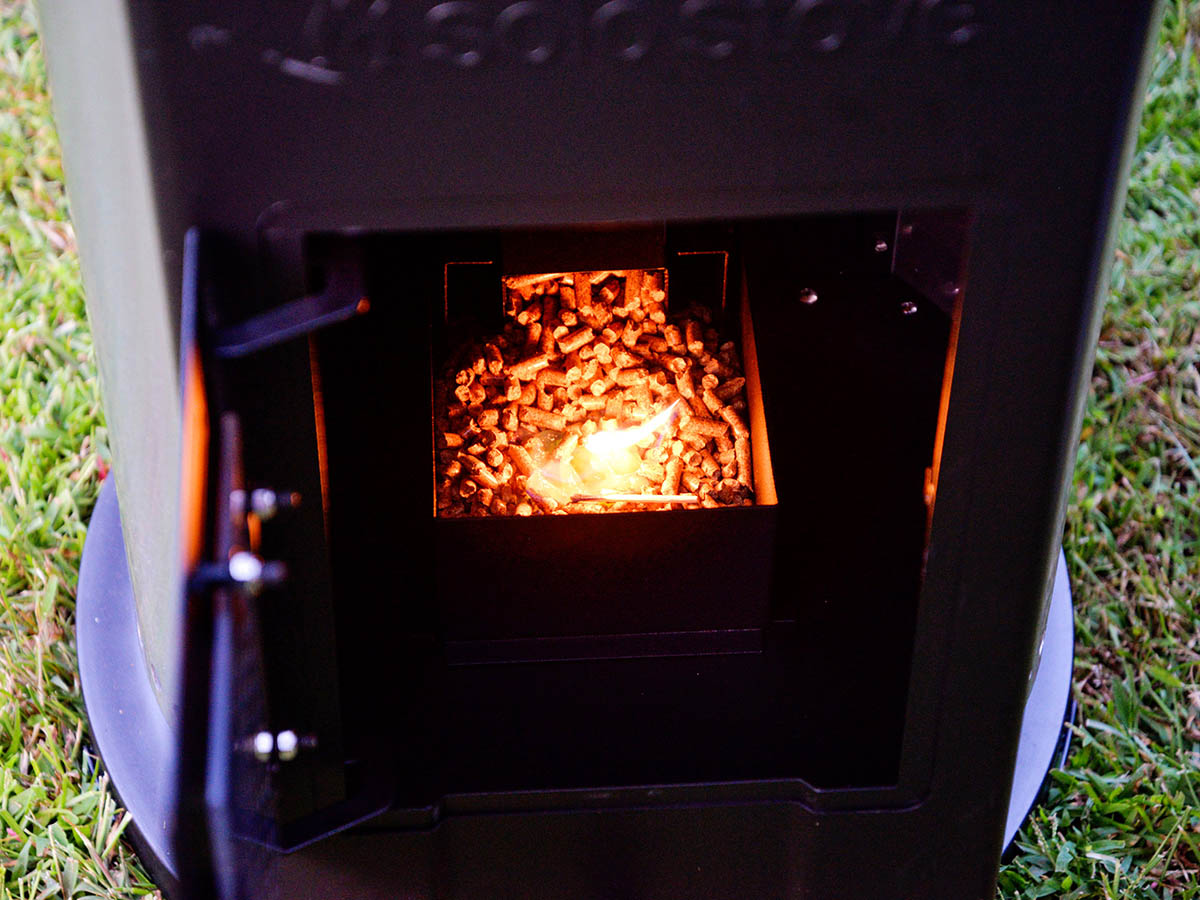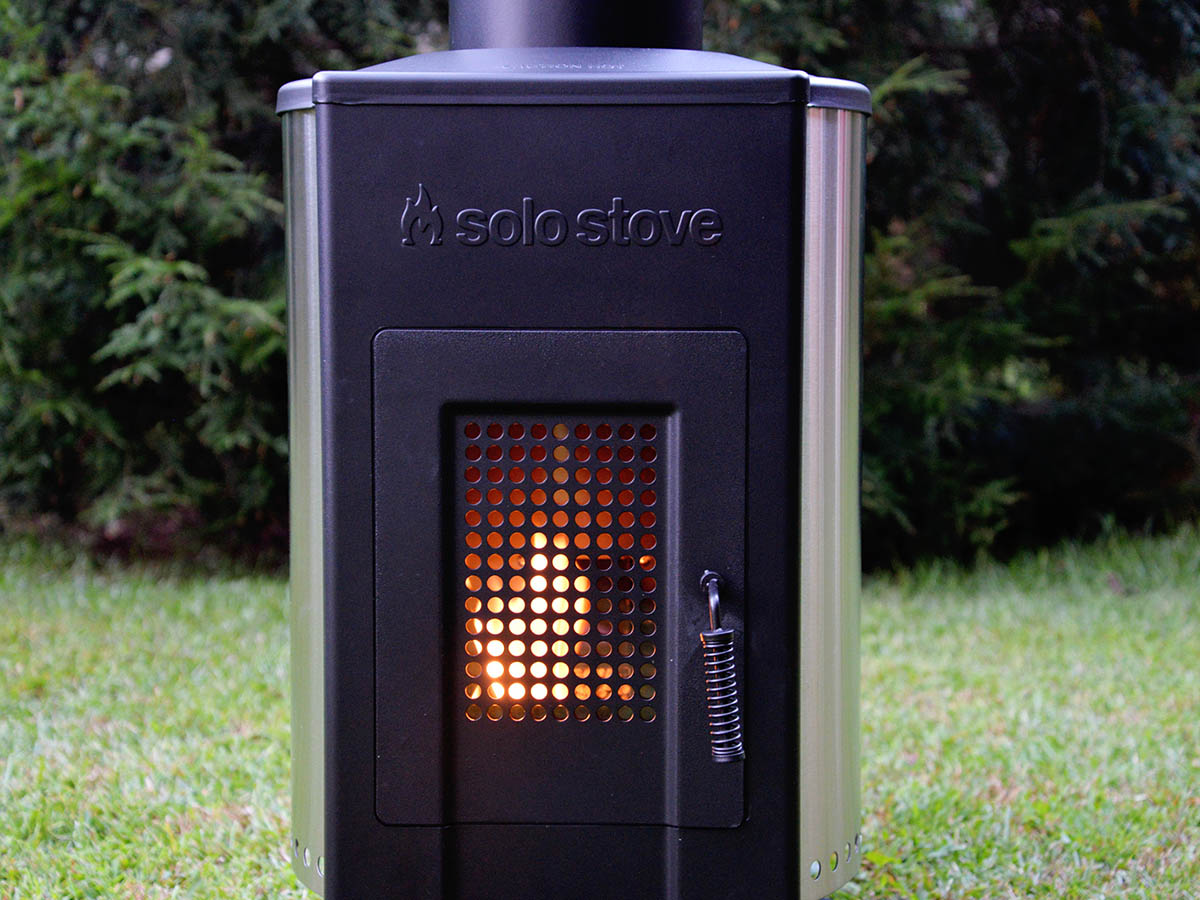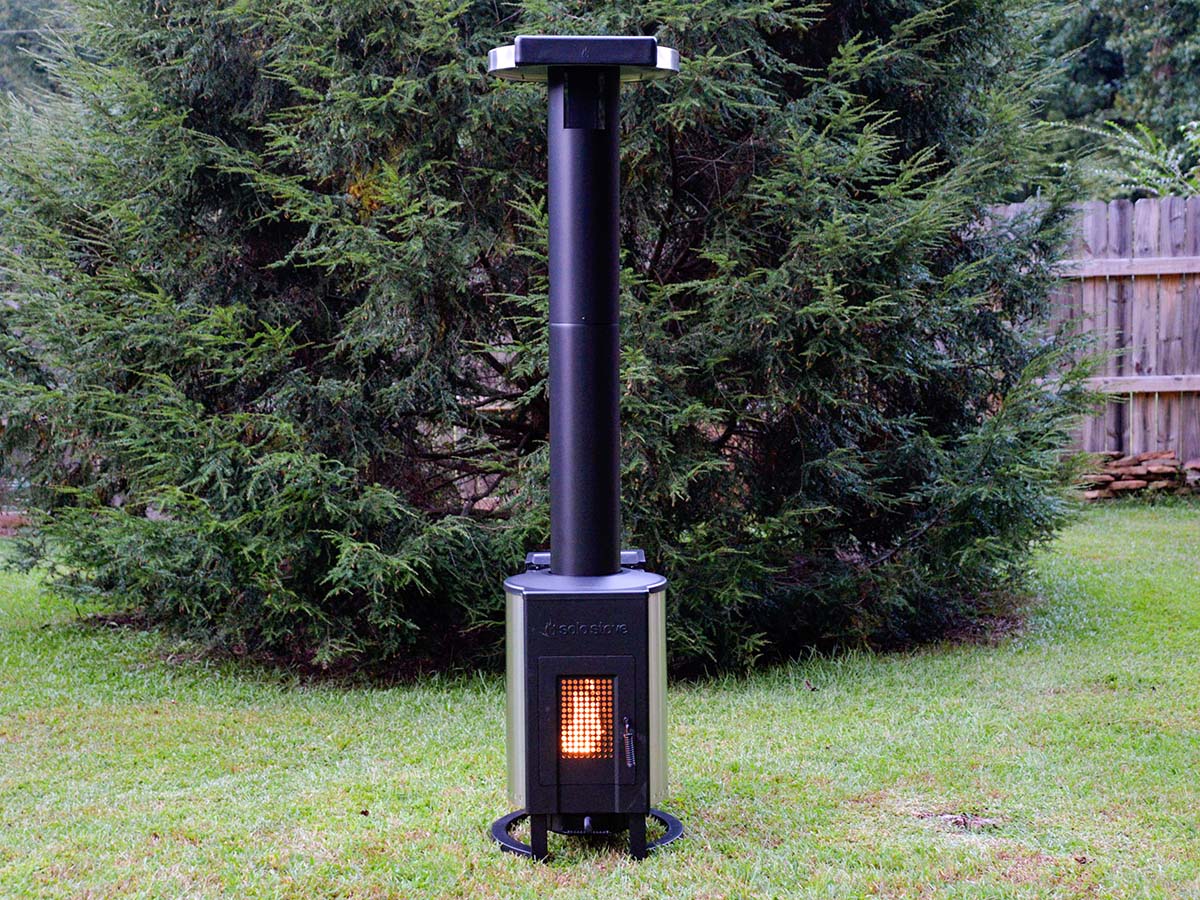We may earn revenue from the products available on this page and participate in affiliate programs. Learn More ›
Outdoor patio heaters extend the usefulness of decks, patios, and other outdoor living spaces into the cool and crisp parts of the year. Traditionally, the available options have included electric and propane patio heaters, which both come with certain limitations. Electric models are simply not very warm due to the limited power available from a standard wall outlet. Propane patio heaters produce more warmth but contribute to long-term air pollution and are more expensive to operate. I tested the Solo Stove Tower patio heater because it offers a cleaner, more powerful outdoor heating option.
Over the past decade or more, Solo Stove has become a leader in the outdoor living industry. Its flagship product, the Solo Stove Bonfire fire pit smokeless invention, showcases the thoughtful design and rugged materials permeating all of the Solo Stove sizes. After enjoying scores of toasty evenings by my own solo stove campfire, I had an opportunity to try out the new Solo Stove wood pellet–fueled patio heater.
Overall, my experience testing the Solo Stove Tower was really good. As with anything, it will not solve every issue for every shopper; but it is well constructed, easy to operate, and puts out a nice amount of heat. I included a brief account in a comprehensive patio heater shopping guide. The Solo Stove Tower patio heater review ahead offers more in-depth details with regard to assembly, operation, and changes that occur after burning several fires in the heater.
Solo Stove Tower Patio Heater: At a Glance

Rating: 8.8/10
SPECS
- Fuel type: Wood pellets
- Fuel capacity: 25 pounds
- Heat output: 72,000 British thermal units (BTUs)
- Dimensions: 80.5 inches tall by 19.8 inches wide by 23.3 inches deep
- Weight: 104 pounds
PROS
- Excellent full-height heat production; radiates 360 degrees to warm up to a 10- to 12-foot diameter
- Gravity-fed pellet hopper offers up to 3 hours of burn time with no need to tend the fire
- Burn chamber window emits a pleasant fire glow for added ambience
- Higher heat output and less expensive to operate than propane patio heaters
- Low smoke production: eco-friendly and won’t cause allergies to flare up
CONS
- More expensive purchase price than electric or propane patio heaters
- Takes 10 to 15 minutes for the stove to heat up before the surrounding area becomes warm
- Bulky build and heavy materials make it difficult to move, even with built-in handles and wheels
- Must be protected from the weather, but the protective cover is not included
Get the Solo Stove Tower patio heater at:
What is the Solo Stove Tower patio heater?
The Solo Stove Tower patio heater is designed to bring the physical warmth and ambience of a fireplace to the outdoor living area. Unlike many of the brand’s products that are purpose-built to take along on outdoor adventures, this is not a portable outdoor heater. Constructed of 304 stainless steel and cold rolled steel, it measures 80.5 inches tall by 19.8 inches wide by 23.3 inches deep and weighs in at a hefty 104 pounds.
As a wood-fired patio heater, how does Solo Stove work? It burns environmentally friendly affordable wood pellets. The onboard pellet hopper holds 25 pounds of pellet fuel and uses gravity to automatically feed the fire for up to 3 hours at a time. Inside the firebox, a steel grate in the floor allows fresh air to flow upwards through the fire, leading to an intense flame while burning only a few ounces of fuel at any given time. As the solo stove pellets burn up, the tiny amount of ash that is produced falls through the grate and into the ash pan below for easy disposal.
The Tower works something like a compact wood stove or chiminea. The firebox stands about 6 inches off the ground, supported by its base. The pellet hopper is attached at the rear of the unit, with a chute that allows pellets to slide down onto the burn grate inside the firebox. A steel “valve” at the base of the chute remains open while the fire burns, but may be closed to stop the flow of pellets to let the fire burn out.
The base of the chimney is positioned directly above the burn grate, not offset like a typical wood stove, and it has no damper. This configuration allows maximum airflow through the fuel at all times, consequently maximizing heat output and eliminating most smoke particles. The firebox must remain closed during operation to maintain proper ventilation through the chimney, but a window in the firebox door lets you enjoy the bright flickering firelight as you bask in the warmth.

How easy is it to assemble the Solo Stove Tower patio heater?
The Solo Stove Tower arrived in two separate boxes: one containing the chimney parts and the other with the main firebox assembly, the rest of the smaller parts, and hardware. Assembly took about 30 minutes with easy-to-follow instructions. The most complicated parts were preassembled at the factory, with only the firebox door, hopper lid, fire grate, chimney, and handles to add on.
The only minor hiccup I encountered was a blemish in the rim of the pellet hopper that had occurred in shipping. One of the corners had been pushed in, creating indents on two sides of the rim that should have been straight, so the hopper lid would not close as it’s supposed to. I could have made a claim with the shipper and requested a new stove, but instead, I straightened the metal using a pair of pliers with cardboard padding the jaws to protect the heater’s finish. It ended up workable but not perfect.
My suggestion to those who purchase this unit is to carry the boxes to the patio and build it on-site, if possible. The assembled heater is heavy and more cumbersome to move than it might appear. The best way to move the assembled unit across unpaved ground is with a hand truck, with at least one helper to steady the load.

Can I set a Solo Stove Tower on a patio or other surface without damaging anything?
Since it is elevated several inches above the surface, it seemed likely that the Solo Stove Tower would be safe to assemble on any surface. The Solo Stove instructions leave room for interpretation with regard to the placement of the Tower heater, so I tested for this as well. While the heater was in operation, I reached under it and felt the ground with my bare hand. The temperature beneath the heater remained cool to the touch even while the walls of the firebox were dangerously hot.
Even though the underside of the tower remains cool, the hot sides and chimney are fire hazards. As such, it is important to set up a safe horizontal distance at a minimum of 6 feet away from buildings and other flammable materials. Also, be sure to leave plenty of vertical clearance, 15 feet or higher, above the top of the chimney.
Is the Solo Stove Tower patio heater easy to use?
Operating the Solo Stove Tower was very easy. I filled the hopper and opened the chute. Then I opened the firebox door and placed about a tablespoon of alcohol gel fire starter into the middle of the pellet pile, lit it, and closed the door. It took about 10 minutes for the fire to build up before the stove produced detectable heat, and about 20 minutes before it came to full temperature.
The first time I made a fire in the Tower heater, it began to smoke after about 15 minutes. The smoke gradually increased and soon was out all around the door and lower chimney, while soot started to build up inside the firebox window. As I waited and watched, the fire continued to build, the smoke abated, and the soot gradually disappeared. After the fire cooled, the appearance of both the stainless steel and the coated steel had changed. The stainless had taken on a bronze tone, while the coated steel on the front of the firebox and lower portion of the chimney had become more matte in appearance. This only happened on the first burn, and neither the smoke nor any additional patina has developed since.
The only feature I found lacking in the Solo Stove Tower was a way to control the heat. In a wood stove, that would be done by adjusting the airflow with a damper and by feeding more or less fuel. This heater is designed to produce maximum flame and heat at all times. Adding control mechanisms would give users the ability to conserve fuel when the temperatures are marginally cool.

Does the Solo Stove Tower patio heater give off enough heat?
I compared the heat radiating from the Solo Stove Tower patio heater to that produced by the Hampton Bay propane patio heater. Statistically, the Solo Stove Tower produces more heat (72,000 BTUs) than the gas-powered Hampton Bay model (48,000 BTUs), but there is more to the story. The Solo Stove Tower produces heat inside the firebox at ground level and radiates heat along its full height, but the Hampton Bay is built with a gas burner near its top, with a dome above to reflect some of the heat downward.
The effect is that the Solo Stove Tower heats the surrounding area more thoroughly with higher overall heat production radiating from a low point. Conversely, the Hampton Bay concentrates more heat within a smaller area near its top. While the gas-powered heater created a comfort zone within a 4.5-foot radius, the Solo Stove radiated a circle of heat that could be felt as far as 6 feet away.

Does the Solo Stove Tower need a lot of care and maintenance?
The Solo Stove Tower is easy to care for, but it does need some protection from the elements. To clean up after a fire or before starting the next one, a quick top-down dust off will suffice. I close the hopper chute, lift out the metal bracket that holds the pellets from the firebox, sweep any ashes or debris through the grate, and give it a good shake. I replace the metal pellet bracket, close the door, and empty the ash pan. Then it’s ready for the next burn.
It’s fine to leave the Solo Stove Tower outside overnight, but the manufacturer advises that it must be covered when not in use. That makes sense in order to keep water from accumulating inside the stove where wood pellets might absorb it. But the problem is that the heater does not come with a cover. I have been using a tarp to cover mine, but the manufacturer makes a rainproof cover called the Tower Shelter. If the shelter is required, and the unit is very difficult to move, a more customer-friendly move would have been to include the shelter in the purchase.
Is the Solo Stove Tower patio heater worth the money?
The Solo Stove Tower is a unique product that appears to have only one widely available competitor. The visually similar Even Embers Pellet patio heater ranges in price from about $399.99 to $565.94, depending on the specific retailer. Priced at $699.99, the upfront Solo Stove cost is higher, but it is also the higher-quality product for a couple of reasons.
Both products are rated significantly higher than gas heaters, but the Solo Stove Tower holds the edge with a 72,000 BTU rating, while the Even Embers Heater puts out 70,000 BTUs. While they are both able to heat approximately 100 square feet, the Solo Stove’s heat will be more intense and may reach up to 314 square feet. Another indication of this is that Solo Stove claims a burn time of 3 hours, while Even Embers claims 6 hours of burn time, both for 25 pounds of pellets. Burning more pellets faster produces more heat.
What is more concerning about the Even Embers model is its lightweight build. Comparing the dimensions and construction of the two products, the Solo Stove Tower is just a bit smaller than the Even Embers model (which measures 84 inches tall by 22.5 inches wide by 25.5 inches deep). But the stainless steel Solo Stove is also about 30 pounds heavier than the 72.5-pound Even Embers heater, which is made of coated steel. This indicates that the Even Embers model is made from thinner metal that is more likely to be warped by exposure to high heat.
The Solo Stove Tower patio heater is a solid option that offers a unique heating experience. It costs more than the competition, but that is at least in part because of its heavy-duty construction. The premium price point may exclude bargain hunters, but in my view, it is a fair price.

Should you buy the Solo Stove Tower patio heater?
If you’ve already invested in the Solo Stove product line, then adding the Tower patio heater should be an easy choice. It continues the tradition of bringing people together around a bright backyard fire, while the quality of design and construction is right there with the rest of the Solo Stove product line.
However, not every shopper will love dealing with the purchase and storage of wood pellets. They are more difficult than propane to buy locally. Sometimes the bags are not sealed, leaving you with a mess of “sawdust” to clean up. But when it comes to warming the patio, the Solo Stove Tower adds layers of value, with a better overall heating effect and cleaner fuel than propane tower heaters. Plus, you get the warm flickering flame that only comes from a wood burner.
Where to Buy the Solo Stove Tower Patio Heater
Get the Solo Stove Tower patio heater at:
Meet the Tester
Mark Wolfe is a product tester and writer with an extensive background in the nursery and landscaping industry. He kept his tool box well stocked in order to build or repair fences, walls, irrigation systems, and equipment on any given day. Now he tests and writes reviews about the latest hand tools, lawn-care products, outdoor power equipment, and other outdoor-living goods.


